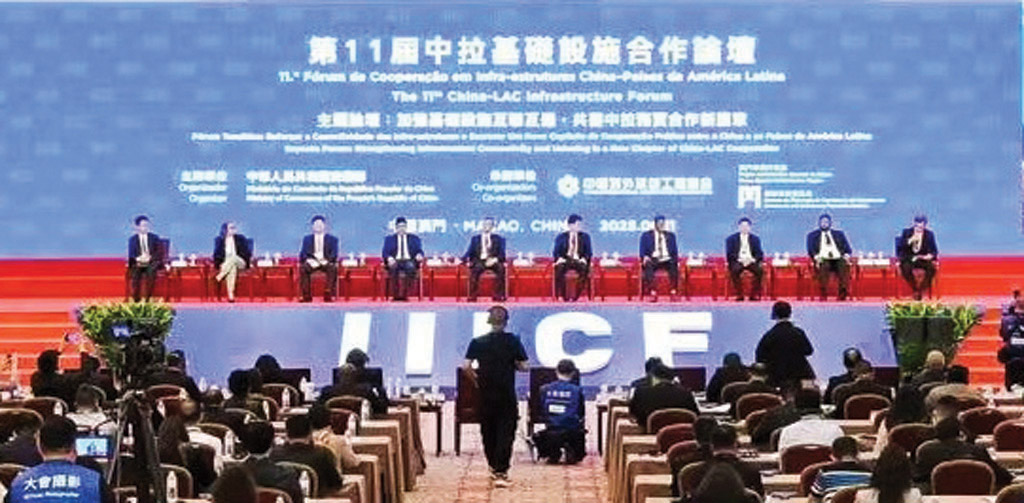Foreign officials at Macao event voice hope for greater Chinese participation in key projects

Decision makers from countries and regions involved in the Belt and Road Initiative (BRI) have expressed hopes of fostering more international collaboration, as the project’s global reach continues to expand in scale and scope.
They made their remarks at the 16th International Infrastructure Investment and Construction Forum and Exhibition (IIICF), which ended on June 12 in the Macao Special Administrative Region.
This year, the three-day forum hosted over 250 activities, facilitating more than 200 business meetings and matchmaking sessions. It also saw the signing of 31 cooperation agreements in sectors such as transportation, construction, electricity, water conservation and new energy, with a total contract value of $10.1 billion.
The 8,000-square-meter exhibition featured over 80 leading infrastructure enterprises and contractors, offering visitors a wealth of cooperative achievements under the BRI framework and innovative infrastructure solutions.
During an interview with China Daily, Solomon Islands’ infrastructure development minister Ricky Fuo’o named several Chinese construction giants he hopes to collaborate with further, including China Civil Engineering Construction Corp, China Harbour Engineering Co, and China Railway.
“The exhibition is an eye-opener for us. Looking at those massive Chinese companies that are here, the infrastructure that can be built in collaboration with these companies … I have a lot of potential plans in mind,” Fuo’o said.
Solomon Islands became a BRI partner in 2019. Fuo’o highlighted China’s support for his nation’s large-scale road infrastructure projects. “Roads connect people … As the Chinese say, if you want to get rich, you build a road,” he said.
Fuo’o added that he plans to explore additional financing facilities on offer to enhance the country’s financing capacity, which he said was “the only thing that’s going to hinder us” from deepening infrastructure collaboration with China.
Soulivath Souvannachoumkham, Laos’ deputy minister of finance, also highlighted the “quite substantial changes” the BRI projects had brought to his country.
“The BRI can help Laos transform from a landlocked to a land-linked country,” he said.
Souvannachoumkham, who was attending the IIICF for the first time, added that he sees new collaboration opportunities in renewable energy, with Chinese players demonstrating robust experience and expertise in this field.
Laos has abundant renewable energy resources, such as hydro and wind power. Souvannachoumkham said. He said he hopes that Laos can work with Chinese companies to manage an array of renewable energy sources, including solar, wind, and hydro.
Also attending the forum was a delegation from South Africa’s Limpopo province, including its premier Phophi Ramathuba, as well as the chiefs of public works, road and infrastructure, and economic development.
Last year, China and South Africa elevated their bilateral relationship to an all-around strategic cooperative partnership.
Thilivhali Muavha, spokesperson for the premier, said that Limpopo’s Musina-Makhado and Fetakgomo-Tubatse special economic zones are both flagship programs of the provincial government. “We need investors from China to be part of it,” he added.
Ati Camillo, a lawmaker from Vanuatu, an island nation located in the southwest Pacific Ocean, said, “We have around 20 main islands, and the BRI helps (improve) our interconnectivity between the islands.”
“We are very grateful for that, and we are looking forward to developing it further.”
At the forum’s closing press conference, other visitors spoke of China’s significant work in their countries’ infrastructure sectors.
Riad Nurmohamed, Suriname’s minister of public works, praised the event for providing an experience exchange platform, enabling insights into technological, industrial and developmental trends worldwide to be shared.
The infrastructure projects featured at the exhibition reminded Nurmohamed of when China Dalian International Economic and Technical Cooperation Group — the first Chinese company Suriname worked with — upgraded the country’s roads, cutting through the jungle, over a decade ago.
Nurmohamed also highlighted his country’s pressing need for more afforestation projects to mitigate climate change, as this is taking a heavy toll on Suriname and other low-lying countries that are at risk due to rising sea levels.
Abdul Latheef Mohamed, Maldives’ minister of state for transport and civil aviation, spoke highly of his country’s Velana International Airport, the expansion of which was undertaken by the Beijing Urban Construction Group, and of the China-Maldives Friendship Bridge, the first cross-sea bridge in the Indian Ocean, built by China Communications Construction Co. These are projects that have brought tangible benefits to the Maldivian people and foreign tourists, he said.
“The doors to the Maldives are wide open for you,” Mohamed said.
Also addressing the news conference, Kenya’s Principal Secretary of the State Department of Water and Sanitation Julius Korir outlined the construction plans that had been discussed between Kenyan officials and global investors and contractors during the three-day event. These included bridge construction, rail network expansion, and the upgrading of water and sanitation facilities.
Contact the writer at wanqing@chinadailyhk.com


